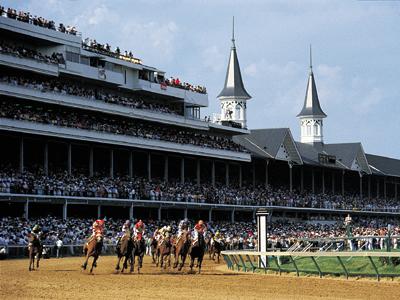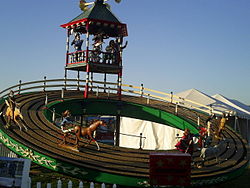Listen to “The Kentucky Derby Alexandra shares her thoughts” on Spreaker.
The Kentucky Derby is an American Grade I stakes race run at Churchill Downs in Louisville, Kentucky. The race is run by three-year-old Thoroughbreds at a distance of one and a quarter miles (2.0 km), the first time horses in the field race that distance. Colts and geldings carry 126 pounds (57 kilograms) and fillies 121 pounds (55 kilograms).
Held annually on the first Saturday in May, the race is the first leg of the Triple Crown. The Derby is known as “The Run for the Roses,” as the winning horse is draped in a blanket of roses. Lasting approximately two minutes, the race has also been called “The Most Exciting Two Minutes in Sports” or “The Fastest Two Minutes in Sports.” It is preceded by the two-week-long Kentucky Derby Festival.
The race was first run in 1875. Unlike the other races of the Triple Crown, the Preakness Stakes and the Belmont Stakes, the Derby has been run continuously since its first edition. The race was rescheduled due to the COVID-19 pandemic in 2020 and World War II in 1945.
The Derby is the most-watched and most-attended horse race in the United States.
The 149th running of the Kentucky Derby took place on Saturday, May 6, 2023.
History
In 1872, Col. Meriwether Lewis Clark Jr., grandson of William Clark of the Lewis and Clark expedition, traveled to England, visiting Epsom in Surrey where The Derby had been running annually since 1780.[6] From there, Clark went on to Paris, France, where a group of racing enthusiasts had formed the French Jockey Club in 1863. They had organized the Grand Prix de Paris at Longchamp, which at the time was the greatest race in France. Returning home to Kentucky, Clark organized the Louisville Jockey Club to raise money for building quality racing facilities just outside the city. The track would soon become known as Churchill Downs, named for John and Henry Churchill, who provided the land for the racetrack. The naming went official in 1937.
Aristides, ridden by Jockey Oliver Lewis, won the first Kentucky Derby.
The Kentucky Derby was first run at 1+1⁄2 miles (12 furlongs; 2.4 km) the same distance as the Epsom Derby, before changing lengths in 1896 to its current 1+1⁄4 miles (10 furlongs; 2 km). On May 17, 1875, in front of an estimated crowd of 10,000 people, a field of 15 three-year-old horses contested the first Derby. Under jockey Oliver Lewis, a colt named Aristides, who was trained by future Hall of Famer Ansel Williamson, won the inaugural Derby. Later that year, Lewis rode Aristides to a second-place finish in the Belmont Stakes.
Initially a successful venue, the track ran into financial difficulties due to a protracted, gambling-relatedhorseman boycott removing it from the upper echelons of racing that would last until the Winn era (see below). In 1894 the New Louisville Jockey Club was incorporated with the new capitalization and improved facilities. Despite this, the business floundered until 1902, when a syndicate led by Col. Matt Winn of Louisville acquired the facility. Under Winn, Churchill Downs prospered, and the Kentucky Derby then became the preeminent stakes race for three-year-old thoroughbred horses in North America.
Thoroughbred owners began sending their successful Derby horses to compete in two other races. These two are the Preakness Stakes at the Pimlico Race Course, in Baltimore, and the Belmont Stakes in Elmont, New York. The three races offered large purses, and in 1919 Sir Bartonbecame the first horse to win all three races. However, the term Triple Crown didn’t come into use for another eleven years. In 1930, when Gallant Fox became the second horse to win all three races, sportswriter Charles Hatton brought the phrase into American usage. Fueled by the media, public interest in the possibility of a “superhorse” that could win the Triple Crown began in the weeks leading up to the Derby. Two years after the term went in use, the race (until that time ran in mid-May since inception) changed the date to the first Saturday in May. This change allows for a specific schedule for the Triple Crown races. Since 1931, the order of Triple Crown races has been the Kentucky Derby first, followed by the Preakness Stakes and then the Belmont Stakes. Before 1931, eleven times the Preakness was run before the Derby. On May 12, 1917, and again on May 13, 1922, the Preakness and the Derby took place on the same day. On eleven occasions the Belmont Stakes was run before the Preakness Stakes, and in 2020, the Belmont was run first, then the Kentucky Derby, and the Preakness Stakes last.
Churchill Downs in 1901
On May 16, 1925, the first live radio broadcast of the Kentucky Derby aired on WHAS as well as on WGN in Chicago. On May 7, 1949, the first television coverage of the Kentucky Derby took place, produced by WAVE-TV, the NBC affiliate in Louisville. This coverage was aired live in the Louisville market and sent to NBC as a kinescope newsreel recording for national broadcast. On May 3, 1952, the first national television coverage of the Kentucky Derby took place, aired from then-CBS affiliate WHAS-TV. In 1954, the purse exceeded US$100,000 for the first time. In 1968, Dancer’s Image became the first horse to win the race and then face disqualification. A urine test revealed traces of phenylbutazone (an anti-inflammatory painkiller drug) inside Dancer’s Image. Forward Pass won after a protracted legal battle by the owners of Dancer’s Image (which they lost). Forward Pass thus became the eighth winner for Calumet Farm. Unexpectedly, the regulations at Kentucky thoroughbred race tracks were changed some years later, allowing horses to run on phenylbutazone. In 1970, Diane Crump became the first female jockey to ride in the Derby, finishing 15th aboard Fathom.[11]
The fastest time ever run in the Derby was in 1973 at 1:59.4 minutes, when Secretariat broke the record set by Northern Dancer in 1964. Also during that race, Secretariat did something unique in Triple Crown races: for each successive quarter run, his times were faster. Although the races do not record times for non-winners, in 1973 Sham finished second, two and a half lengths behind Secretariat in the same race. Using the thoroughbred racing convention of one length equaling one-fifth of a second to calculate Sham‘s time, he also finished in under two minutes. Another sub-two-minute finish, only the third, was set in 2001 by Monarchos at 1:59.97, the first year the race used hundredths of seconds instead of fifths in timing.
In 2005, the purse distribution for the Derby changed, so that horses finishing fifth would henceforth receive a share of the purse; previously only the first four finishers did so.
The Kentucky Derby began offering $3 million in purse money in 2019. Churchill Downs officials have cited the success of historical race wagering terminals at their Derby City Gaming facility in Louisville as a factor behind the purse increase. The Derby first offered a $1 million purse in 1996; it was doubled to $2 million in 2005.
In 2020, The Kentucky Derby was postponed from May 2 to September 5 due to the COVID-19 pandemic. This was the second time in history the race had been postponed, the other being in 1945. Churchill Downs used a new singular 20-stall starting gate for the 2020 Kentucky Derby, replacing the previous arrangement that used a standard 14-stall gate and an auxiliary six-stall gate.The old setup contributed to congestion at the start of the race, especially in the gap between the two gates.
The Kentucky Derby is the oldest continuously held major sporting event in the United States (1875).
Attendance
Millions of people from around the world bet at various live tracks and online sportsbooks. In 2017, a crowd of 158,070 watched Always Dreaming win the Derby, making it the seventh biggest attendance in the history of the racetrack. The track reported a wagering total of $209.2 million from all the sources on all the races on the Kentucky Derby Day program. It was a 9 percent increase compared to the total of $192.6 million in 2016 and an increase of 8 percent over the previous record set in 2015 of $194.3 million. TwinSpires, a platform for betting online and a partner of the Kentucky Derby and the Breeders’ Cup, recorded $32.8 million in handle on the Churchill Down races for the Kentucky Derby Day program. This record was a 22 percent increase over the preceding year. On the Kentucky Derby race alone, the handle of TwinSpires was $20.1 million, which is a 22 percent rise compared to the prior year.
The race often draws celebrities. HM Queen Elizabeth II, on a visit to the United States, joined the racegoers at Churchill Downs in 2007.
Sponsorship
The 2004 Kentucky Derby marked the first time that jockeys —as a result of a court order— were allowed to wear corporate advertising logos on their clothing.
Norman Adams has been the designer of the Kentucky Derby Logo since 2002. On February 1, 2006, the Louisville-based fast-food company Yum! Brands, Inc. announced a corporate sponsorship deal to call the race “The Kentucky Derby presented by Yum! Brands.”[22] In 2018 Woodford Reserve replaced Yum! Brands as the presenting sponsor.[1]
Traditions
In addition to the race itself, several traditions play a significant role in the Derby atmosphere. The mint julep—an iced drink consisting of bourbon, mint, and sugar syrup—is the traditional beverage of the race. The historic beverage comes served in an ice-frosted silver julep cup. However, most Churchill Downs patrons sip theirs from souvenir glasses (first offered in 1939 and available in revised form each year since) printed with all previous Derby winners. Also, burgoo, a thick stew of beef, chicken, pork, and vegetables, is a popular Kentucky dish served at the Derby.
Louisville Clock (often called the Louisville Derby Clock), which was dismantled in 2015
The infield—a spectator area inside the track—offers general admission prices but little chance of seeing much of the race, particularly before the jumbotron installation in 2014. Instead, revelers show up in the infield to party with abandon. By contrast, “Millionaire’s Row” refers to the expensive box seats that attract the rich, the famous and the well-connected. Women appear in elegant outfits lavishly accessorized with large, elaborate hats. Following the Call to the Post played on bugle by Steve Buttleman, as the horses start to parade before the grandstands, the University of Louisville Cardinal Marching Band plays Stephen Foster‘s “My Old Kentucky Home“. This song is a tradition which began in 1921. The event attracts spectators from a large area, flying in hundreds of private aircraft to Louisville International Airport.
The Derby is frequently referred to as “The Run for the Roses“, because a lush blanket of 554 red roses is awarded to the Kentucky Derby winner each year. The tradition originated in 1883 when New York City socialite E. Berry Wall presented roses to ladies at a post-Derby party. The Churchill Downs founder and president, Col. M. Lewis Clark, attended that event. This gesture is believed to have led Clark to the idea of making the rose the race’s official flower. However, it was not until 1896 that any recorded account referred to draping roses on the Derby winner. The Governor of Kentuckyand the Chairman of Churchill Downs Incorporated present the garland and the Kentucky Derby Trophy to the winner. Pop vocalist Dan Fogelbergcomposed the song “Run for the Roses“, released in time for the 1980 running of the race.






 Thought for the Day…05/24/23
Thought for the Day…05/24/23